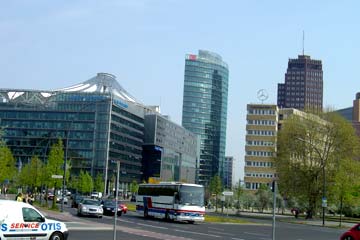











In the 18th-century the 'Platz vor dem Potsdamer Thor', was created in the heart of Berlin and received in July 1831 its present name. Before the 2nd World War it was Europe's busiest place, where five of Berlin's liveliest roads crossed. Potsdamer and the eastern situated Leipziger Platz form the connection in terms of traffic between Berlin's eastern and western part. In the year 1925 600 trams crossed the place hourly, policed by a constable, who sat in the places' symbol a traffic tower with a clock and Germany's first traffic light facility. Nobel hotels and over 100
restaurants, among others the "Haus Vaterland", with 2000 seats Europe's largest restaurant, attract thousands of tourists to the place. On the 1st of May 1916, Karl Liebknecht was arrested here and during the Nazi time, the infamous People's Court passed in the time from 1942 - 1945 over 5000 death sentences. The place is hollowed out with underground passages and rooms and from the Fuehrer's bunker Adolf Hitler gave the insane order in April 1945 to continue the war before he finally committed suicide. Not a lot is left of the places' former buildings. After the construction of the Berlin Wall the place became no-man's-land between the two city halves. The railway traffic under the place was also terminated and all connections to the city's west part were walled up. Watchtowers, death strips, barbed wire and tank barricades coin the picture of the desolate area until 1989.

After the city's re-unification, the new construction of the Potsdamer Platz started and became Europe's biggest building site. For around 4 billion Marks the new place was developed, 2,3 million tonnes soil was dug out, 549000 cubic metre concrete was used, at times there were 80 divers on duty in the created building lakes and 4500 builders worked there. The Daimler-Chrysler Areal was constructed after a master-plan by Renzo Piano and Christoph
Kohlbecker, an international architect team was responsible for the design of every individual building. Apartments, offices, cinemas, hotels, restaurants, cafes, shops, a gambling casino and a musical theatre were newly created in this place. Impressive are the 'Office-Basilica' of the debis-AG by Renzo Piano with terracotta facade and a "lighthouse" at the nightly city and the Sony-Centre with an enormous glass facade. Together with the Leipziger Platz the Potsdamer Platz becomes once again the hub of Berlin.
City District: Centre
Transport Links
S-Bahn S1,S2 Potsdamer Platz
U-Bahn U2 Potsdamer Platz
Bus 148,124,248